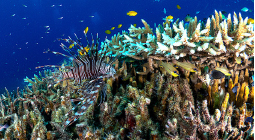In Southern Leyte

TACLOBAN CITY – The persistent presence of crown of thorns (COTS), locally known as ‘dap-ag’, in the coastal waters of Sogod Bay poses a significant threat to the coral reefs in Panaon Bay.
This issue also impacts the local fishing community and the tourism sector.
The COTS infestation has been recorded in the territorial waters of Liloan, Libagon, San Francisco, Malitbog, and Padre Burgos, and has been a recurring problem since 2012.
COTS is one of the world’s largest starfish species, with venomous spikes covering its body, posing a danger to both humans and marine life.
Currently, local volunteers and conservation groups are implementing measures to address this problem, but they need more help and resources to prevent the spread of COTS to more coral areas in Panaon Island which is recognized as one of the priority reefs worldwide due to its resilience to climate change.
Leading the effort are members of the Dap-ag Boys, a group of volunteers headed by Ryan Tomol.
In their clean-up drive conducted last month, they collected 3,000 COTS within Liloan Bay.
However, according to Tomol, their efforts are insufficient due to a lack of resources and manpower. Currently, only 12 members actively participate in the clean-up drive, as other volunteers have found jobs outside the province and region.
The group receives support from Oceana, an international advocacy organization promoting ocean conservation and protection, in partnership with government agencies, local government units, and non-government organizations.
“Connecting with Oceana has allowed us to receive assistance, but we need more help,” Tomol said.
“Without healthy coral reefs, our fishery sector is greatly affected,” Tomol added, emphasizing that the need to protect corals transcends political beliefs, affiliations, personal differences, and territorial boundaries.
The House of Representatives has approved a bill authored by Christopherson Yap of Southern Leyte 2nd district declaring Panaon Island as a protected seascape under the Expanded National Integrated Protected Areas System (ENIPAS) Act or Republic Act 11038.
The bill is now in the Senate, awaiting approval in the third reading.
The proposed Panaon Island protected seascape encompasses 61,204 hectares, covering the municipalities of San Ricardo, Pintuyan, San Francisco, and Liloan.
Oceana stated that the anticipated passage of the bill by the Senate would help strengthen the conservation and protection of the island’s resources for future generations.
The passage of the Senate bill and the sustainable management practices under ENIPAS can contribute to the sustainability and longevity of the island’s ecosystems, according to a socio-economic survey conducted among Panaon Island residents by the University of the Philippines Tacloban and Oceana in 2020.
The bill’s passage will also strengthen the island’s protection, significantly aiding the local governments of Liloan, Pintuyan, San Ricardo, and Pintuyan in addressing the threats faced, while ensuring the thriving abundance of the island’s ecosystems.
Oceana and the Department of Environment and Natural Resources have been collaborating with local stakeholders to prepare them to participate effectively in the plan’s development.
“The management plan is crucial because it ensures the protection and proper management of the island’s resources by all stakeholders for the benefit of the people of Panaon,” said Atty. Rose-Liza Osorio, Oceana’s Senior Director for Campaigns, Legal, and Policy.
“It will also help us achieve this goal by providing a framework for sustainable management practices,” she added.
Panaon Island, with its rich biodiversity, including threatened and endangered wildlife such as whale sharks, sea turtles, rays, the endemic Philippine Duck, vibrant corals, and hundreds of fish species, is aptly called the hidden gem at the tip of Southern Leyte.
Its resilient coral reefs have earned it the distinction of being cited as one of the top 50 in the world that will likely withstand the impacts of climate change. (ROEL T. AMAZONA)



